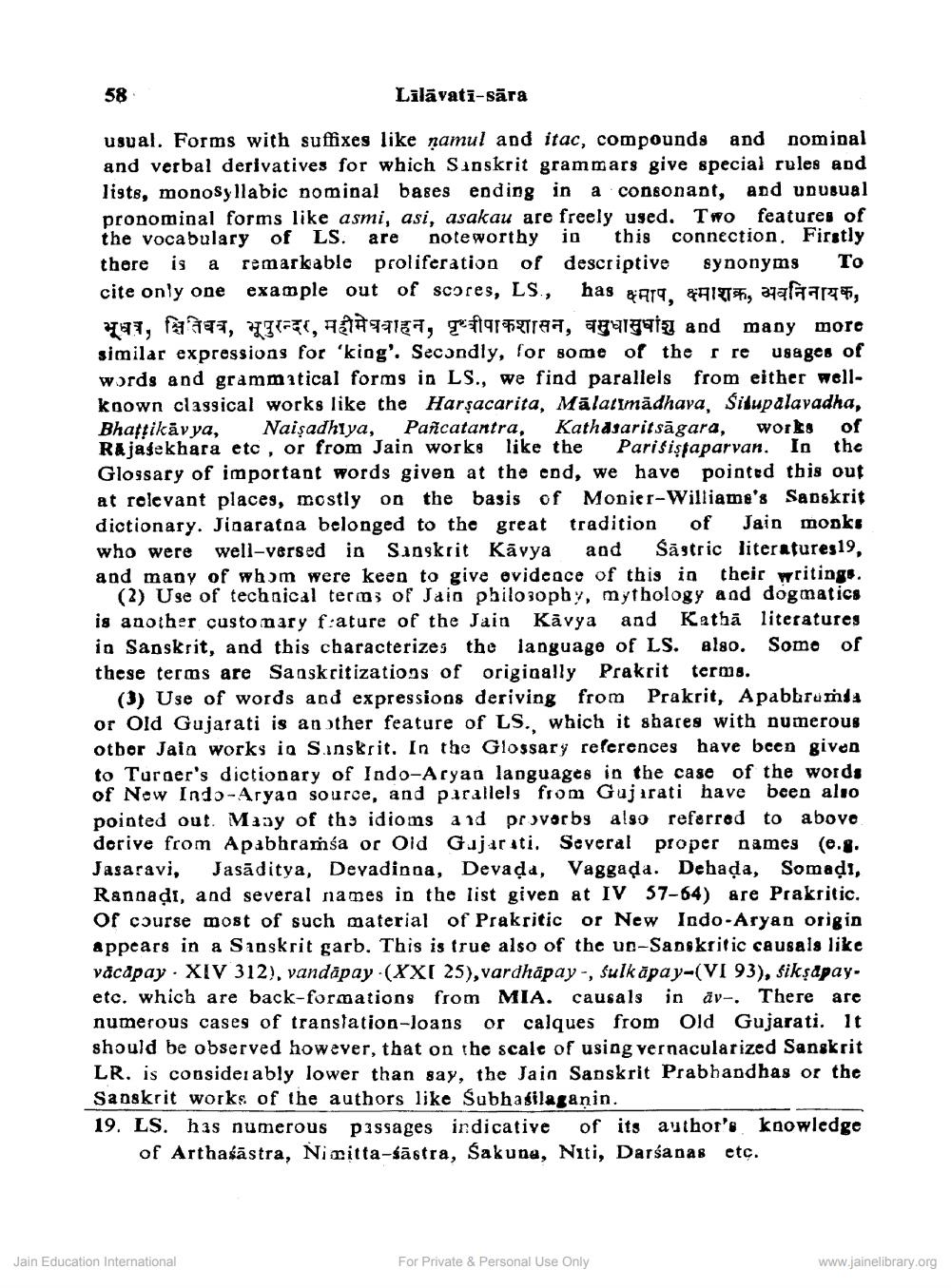________________
58
Lilāvati-sära
usual. Forms with suffixes like namul and itac, compounds and nominal and verbal derivatives for which Sanskrit grammars give special rules and lists, monosyllabic nominal bases ending in a consonant, and unusual pronominal forms like asmi, asi, asakau are freely used. Two features of the vocabulary of LS. are noteworthy in this connection. Firstly there is a remarkable proliferation of descriptive synonyms To cite only one example out of scores, LS, has #ATA, &A1T1, 397 ear, 791, , 10 , HOÀ 99157, Teftrataa, agaigail and many more similar expressions for 'kiog'. Secondly, for some of the r re usages of words and grammatical forms in LS., we find parallels from either wellknown classical works like the Harşacarita, Mālatımädhava, sidupalavadha, Bhattikävya, Naişadhiya, Pañcatantra, Kathasaritsāgara, works of Rajasekhara etc, or from Jain works like the Parisistaparvan. In the Glossary of important words given at the end, we have pointed this out at relevant places, mostly on the basis of Monier-Williams's Sanskrit dictionary. Jinaratoa belonged to the great tradition of Jain monks who were well-versed in Sanskrit Kavya and Sāstric literatures19, and many of whom were keen to give evidence of this in their writings.
(2) Use of technical terms of Jain philosophy, mythology and dogmatics is another custo nary f:ature of the Jain Kavya and Kathā literatures in Sanskrit, and this characterizes the language of LS. also. Some of these terms are Sanskritizatiogs of originally Prakrit terms.
(3) Use of words and expressions deriving from Prakrit, Apabbrumda or Old Gujarati is an other feature of LS.which it shares with numerous otber Jain works in Sinskrit. In the Glossary references have been given to Turger's dictionary of Indo-Aryan languages in the case of the words of New Indo-Aryan source, and parallels from Gujarati have been also pointed out. Many of ths idioms and pryvorbs also referred to above derive from Apabhraíśa or Oid Gujarati. Several proper names (0.8. Jasaravi, Jasāditya, Devadinna, Devada, Vaggada. Dehada, Somadı, Rannadi, and several names in the list given at IV 57-64) &re Prakritic. of course most of such material of Prakritic or New Indo-Aryan origin appears in a Sanskrit garb. This is true also of the uc-Sapskritic causals like våcåpay. XIV 312), vandāpay.(XXI 25), vardhāpay -, sulkāpay-(VI 93), sikşdpay. etc. which are back-formations from MIA. causals in av-. There are numerous cases of translation-loans or calques from Old Gujarati. It should be observed however, that on the scale of using vernacularized Sanskrit LR. is considerably lower than say, the Jain Sanskrit Prabhandhas or the Sanskrit works of the authors like Subhasilaganin. 19. LS. has numerous passages indicative of its author's knowledge
of Arthaśāstra, Nimitta-śāstra, Sakuna, Niti, Darśanas etc.
Jain Education International
For Private & Personal Use Only
www.jainelibrary.org




